Comparative embryology Study guides, Class notes & Summaries
Looking for the best study guides, study notes and summaries about Comparative embryology? On this page you'll find 140 study documents about Comparative embryology.
Page 4 out of 140 results
Sort by
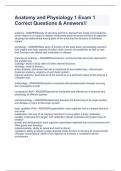
-
Anatomy and Physiology 1 Exam 1 Correct Questions & Answers!!
- Exam (elaborations) • 9 pages • 2023
-
- $10.99
- + learn more
anatomy - ANSWERSstudy of structure and form; derived from Greek word Anatome which means to cut apart or dissect; Anatomists study structure and form of organims studying the relationships among parts of the body and the structure of individual organs physiology - ANSWERSthe study of function of the body parts; physiologists examine how organs and body systems function under normal circumstances as well as how their functions are altered with medication or disease branches of anatomy - AN...
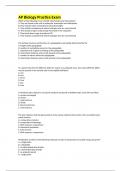
-
AP Biology Practice Exam
- Exam (elaborations) • 3 pages • 2024
-
- $10.39
- + learn more
AP Biology Practice Exam Which of the following is true of both mitochondria and chloroplasts? A. They are found in the cells of eukaryotic autotrophs and chloroplasts B. They include stacks of membranes that absorb light C. They include compartments where hydrogen ions are concentrated D. They produce sugars using energy harvested in the cytoplasm E. They break down sugar to produce ATP C. They include compartments where hydrogen ions are concentrated The tertiary structure and func...
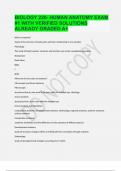
-
BIOLOGY 220- HUMAN ANATOMY EXAM #1 WITH VERIFIED SOLUTIONS ALREADY GRADED A+
- Exam (elaborations) • 14 pages • 2023
- Available in package deal
-
- $14.49
- + learn more
What is anatomy? Study of the structure of body parts and their relationship to one another Physiology The study of body function, structure and function can not be completely separated Brainpower Read More Previous Play Next Rewind 10 seconds Move forward 10 seconds Unmute 0:04 / 0:15 Full screen What are the two sizes of anatomy? Microscopic and Gross Anatomy Microscopic structures that are too small to be seen with the unaided eye. Histology Gross Anatomy...
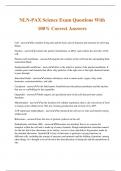
-
NLN-PAX Science Exam Questions With 100% Correct Answers
- Exam (elaborations) • 24 pages • 2024
- Available in package deal
-
- $12.49
- + learn more
NLN-PAX Science Exam Questions With 100% Correct Answers Cell - answerthe smallest living unit and the basic unit of function and structure for all living things. Nucleus - answercontains the genetic information, or DNA, and controls the activities of the cell. Plasma (cell) membrane - answerseparates the contents of the cell from the surrounding fluid (interstitial fluid) Semipermeable membrane - answerrefers to the selective nature of the plasma membrane. It contains pores and channel...
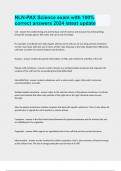
-
NLN-PAX Science exam with 100% correct answers 2024 latest update
- Exam (elaborations) • 47 pages • 2024
-
- $14.99
- + learn more
Cell the smallest living unit and the basic unit of function and structure for all living things. Living cells average approx. 60% water and vary in size and shape. For example, a red blood cell is disk shaped, whereas nerve cells can be very long and have extensions on their main body. Cells also vary in terms of their roles they play in the body. Despite their differences, cells have a number of common features and functions. Nucleus contains the genetic information, or DNA, and co...
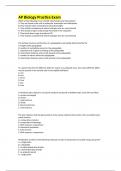
-
AP Biology Practice Exam
- Exam (elaborations) • 3 pages • 2024
-
- $9.59
- + learn more
AP Biology Practice Exam Which of the following is true of both mitochondria and chloroplasts? A. They are found in the cells of eukaryotic autotrophs and chloroplasts B. They include stacks of membranes that absorb light C. They include compartments where hydrogen ions are concentrated D. They produce sugars using energy harvested in the cytoplasm E. They break down sugar to produce ATP C. They include compartments where hydrogen ions are concentrated The tertiary structure and func...
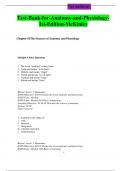
-
Test-Bank-for-Anatomy-and-Physiology-1st-Edition-McKinley
- Exam (elaborations) • 66 pages • 2023
-
- $12.49
- + learn more
1. The word "anatomy" comes from: A. Latin and means "to be born". B. Hebrew and means "shape". C. Greek and means "to cut apart". D. German and means "body". E. Italian and means "form". Bloom's Level: 1. Remember HAPS Objective: A05.01 Define the terms anatomy and physiology. HAPS Topic: Module HAPS Topic: Module A05 Basic terminology. Learning Objective: 01.01.01 Describe the science of anatomy. Section: 01.01 Topic: General 2. Anatomy is the study of: A. st...
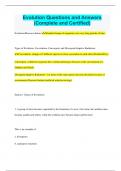
-
Evolution Questions and Answers (Complete and Certified)
- Exam (elaborations) • 20 pages • 2023
- Available in package deal
-
- $9.99
- + learn more
Evolution Questions and Answers (Complete and Certified) Evolution(Macroevolution) Gradual change of organisms over very long periods of time. Types of Evolution- Coevolution, Convergent, and Divergent(Adaptive Radiation) Coevolution- change of 2 different species in close association to each other.(Predator/Prey) Convergent- 2 different organism have similar phenotypes because of the environment.(ex. Dolphin and Shark) Divergent(Adaptive Radiation)- 2 or more of the same species become dissimi...
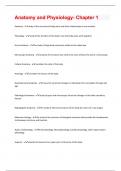
-
Anatomy and Physiology 1 Exam 1 |115 Questions with 100 % correct Answers | Verified
- Exam (elaborations) • 5 pages • 2023
- Available in package deal
-
- $6.49
- + learn more
anatomy - study of structure and form; derived from Greek word Anatome which means to cut apart or dissect; Anatomists study structure and form of organims studying the relationships among parts of the body and the structure of individual organs physiology - the study of function of the body parts; physiologists examine how organs and body systems function under normal circumstances as well as how their functions are altered with medication or disease branches of anatomy - microscopic- str...
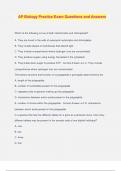
-
AP Biology Practice Exam Questions and Answers
- Exam (elaborations) • 5 pages • 2024
-
- $11.49
- + learn more
AP Biology Practice Exam Questions and Answers Which of the following is true of both mitochondria and chloroplasts? A. They are found in the cells of eukaryotic autotrophs and chloroplasts B. They include stacks of membranes that absorb light C. They include compartments where hydrogen ions are concentrated D. They produce sugars using energy harvested in the cytoplasm E. They break down sugar to produce ATP - Correct Answer ️️ -C. They include compartments where hydrogen ions are co...

Study stress? For sellers on Stuvia, these are actually golden times. KA-CHING! Earn from your study resources too and start uploading now. Discover all about earning on Stuvia


